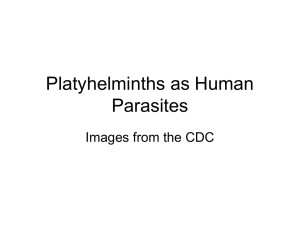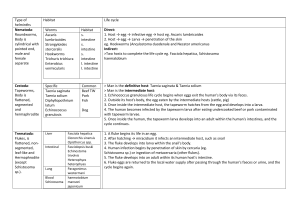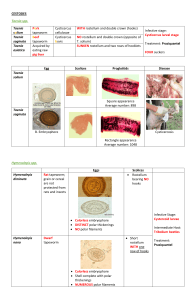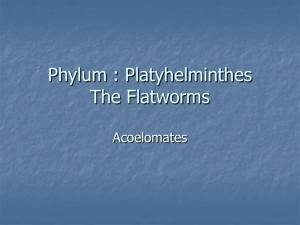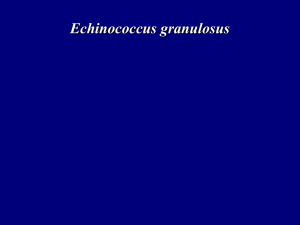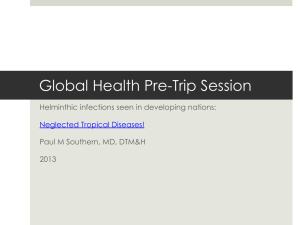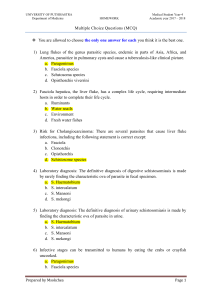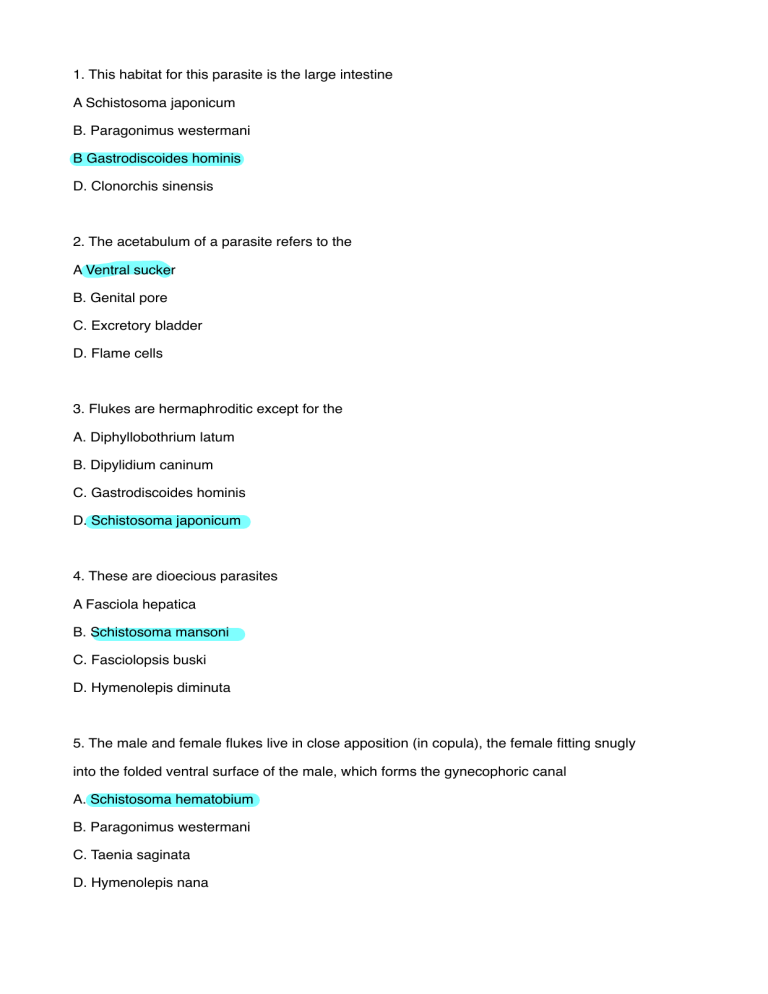
1. This habitat for this parasite is the large intestine A Schistosoma japonicum B. Paragonimus westermani B Gastrodiscoides hominis D. Clonorchis sinensis 2. The acetabulum of a parasite refers to the A Ventral sucker B. Genital pore C. Excretory bladder D. Flame cells 3. Flukes are hermaphroditic except for the A. Diphyllobothrium latum B. Dipylidium caninum C. Gastrodiscoides hominis D. Schistosoma japonicum 4. These are dioecious parasites A Fasciola hepatica B. Schistosoma mansoni C. Fasciolopsis buski D. Hymenolepis diminuta 5. The male and female flukes live in close apposition (in copula), the female fitting snugly into the folded ventral surface of the male, which forms the gynecophoric canal A. Schistosoma hematobium B. Paragonimus westermani C. Taenia saginata D. Hymenolepis nana 6. Excretory system of this parasite consists of flame cells and collecting tubules, which lead to a median bladder opening posteriorly A. Taenia solium B. Echinococcus granulosus C. Heterophyes heterophyes D. Hymenolepis nana 7. Host in the Trematode life cycle which harbor the asexual or larval stages of the parasite A Second intermediate host B Definitive host C Reservoir host D First intermediate host 8 Embryonated eggs of this trematode immediately hatch to form miracidium or L1 larva Schistosoma hematobium Paragonimus westermani Taenia saginata Hymenolepis nana 9 Unembryonated eggs of this trematode embryonate first in water and then hatch Schistosoma hematobium Hymenolepis nana 10 Embryonated eggs of this trematode hatch in the body of the intermediate host A. Taenia solium B. Schistosoma mansoni C Clonorchis sinensis D Hymenolepis nana 11. The first stage larva of trematodes is called A. Metacercaria B miracidium B. Cercaria D-Sporocysts 12. The infective stage of Trematodes, except the Schistosomes, to man A metacercaria B-miracidium C cercana D sporocysts 13. The infective stage of Schistosomes to man A metacercaria B miracidium C cercaria D Sporocysts 14. Paragonimus westermani infection is acquired by ingesting metacercariae encysted in A crab B. fah C. vegetable D snail 15. Clonorchis sinensis infection is acquired by ingesting metacercariae encysted in A crab B. fish C vegetable D Snail 16.Fasciola hepatica infection is acquired by ingesting metacercariae encysted in A crab B fish C. vegetable D snail 17. Fluke inhabiting the human biliary tract A. Taenia solium B Schistosoma mansoni C. Opisthorchis species D. Hymenolepis nana 18Oriental liver fluke A. Clonorchis sinensis B. Dicrocoelium dendriticum C Opisthorchis species D Fasciola hepatica 19 The first intermediate host of Clonorchis sinensis A crab B Fish C. Vegetable D snail 21. The largest and most common liver fluke found in humans A Fasciola hepatica B Schistosoma mansoni C. Fasciolopsis buski D. Hymenolepis diminuta 22 Sheep liver fluke A Paragonimus westermani B Schistosoma hematobium C. Clonorchis sinensis D Pasciola hepatica 23 The smallest trematode infecting humans A Taenia solium B. Echinococcus granulosus C Heterophyes heterophyes D. Hymenolepis nana 24 Characteristic feature of this parasite is a crown of spines on a disc surrounding the ora sucker, justifying its name which means (spiny mouth A Matagonimus yokogawai B Echinococcus granulosus C. Echinostoma species D Echinococcus multilocularis 25 Associated with sheep liver rot A. Paragonimus westermani B. Schistosoma hematobium C. Clonorchis sinensis D-Pasciola hepatica 26. In cases of obstructive jaundice in chronic infection with trematodes, this treatment is necessary A. Use of anti-helminthic B Surgical intervention C Proper cooking of fish D Control of snails 27 Parasite that does not have operculate eggs A Fasciola hepatica B Diphyllobothrium latum C Fasciolopsis buski 28 Ingestion of raw liver infected with this parasite may result in halzoun A Paragonimus westermani B Schistosoma hematobium C Clonorchis sinensis E. Fasciola hepatica 29. Drug of choice for the treatment of fasciogasis A. Praziquantel B Triclabendazole C Prednisolone D Albendazole 42 Cestode which has 2 rows of hooks in its scolex A Echinococcus granulosus B Dipylidium caninum C Hymenolepis diminuta D. Diphyllobothrium latum 43 Presence of an unbranched coiled/convoluted or rosette-like uterus is characteristic of this Cestode A Echinococcus granulosus B. Taenia saginata C. Hymenolepis diminuta D. Diphyllobothrium latum 44. Proglottid of this Cestode is longer than broad with 15-30 uterine branches on each side A Echinococcus granulosus B Taenia saginata C Hymenolepis diminuta D. Diphyllobothrium latum 45 One of the general characteristics of an egg in one of the parasites in this order is that they are covered by 2 layers – egg shell and embryophore A Paramphistomatoidea B. Pseudophyllidea C. Plagiorchioidea D Cyclophyllidea 46 The life cycle of Cestodes is completed in 2 hosts except in this parasite which has only 1 host A. Echinococcus B. Taenia C Hymenolepis D Diphyllobothrium 47 The life cycle of Cestodes is completed in 2 hosts except in this parasite which has 3 Hosts A Echinococcus B. Taenia C. Hymenolepis D Diphyllobothrium 48 In the life cycle of Echinococcus granulosus, its definitive host is A. Man B. Dog C. Fish D. Snail 49 The first intermediate host of this parasite is the fresh water copepod Cyclops A Echinococcus granulosus B. Hymenolepis diminuta C Diphyllobothrium latum 67 The scolex has 4 prominent suckers, retractile rostellum with up to 7 rows of spines Echinococcus granulosus Dipylidium caninum Hymenolepis diminuta D Diphyllobothrium latum 70.Its eggs are infective only to cattle Taenia saginata Schistosoma japonicum Taenia solium Fasciolopsis buski 71. It is the dead end host of the Taenia solium larva because it usually dies without further development A. Cow B. Pig C. Dog D. Man 72. The most common and most serious form of cysticercosis involves the A. Heart B. Brain C. Eyes D. Lungs 73. Laboratory diagnostic test that can differentiate btween the 2 subspecies of taenia saginata - T. s. Saginata and t.s.asiatica A. ELISA B. Indirect immunofluorescence test C. PCR D. INDIRECT Hemagglutination test 74. Definitive method of diagnosis of cysticercosis A. Serodiagnosis B. Biopsy C. Stool examination D. Imaging methods 75. imaging method more helpful in the detection of spinal , non-calcified and ventricular cyst of cysticercosis A.MRI SCAN B. X-rays C. CT SCAN D. ULTRASOUND 76. The germinal layer of the hydatid cyst wall. A. Paracyst B. Pericyst C. Ectocyst D. Endocyst 77. The hydatid cyst wall layer which is compound of characteristic acellular chitinous laminated hyaline material and has the appearance of the white of a hard boiled egg A. Paracyst B. Pericyst C. Ectocyst D. Endocyst 78. Most common site of occurrence of Echinococcus hydatid cyst in the lung A. Left lung , lower lobe B. Right lung , lower lobe C. Left lung , upper lobe D. Right lung , middle lobe 79- The mature strobila contain a lateral thick-lipped genital pore , alternating between the right and left side of adjacent segments A- taenia Saginala B-hymenolepis nana C-taenia solium D-hymenolepos 80. The critical thermal point of cysticarcus is A 56°C for 5 minutes B. 56°C for 10 minutes C. 50°C for 5 minutes D. 50°C for 10 minutes 81.This layer is the vital layer of the cyst and is the site of asexual reproduction giving rise to brood capsules with scolices. It also secretes hydatid fluid, which fils the cyst. A. Ectocyst B. Pericyst C. Paracyst D. Endocyst 82. The most common site of occurrence of hydatid cysts A Liver, Right lobe B. Lung. Left lobe C. Liver, Left lobe D. Lung. Right lobe 83. What is the diagnostic procedure of choice for hydatid, cysts? A. MRI B. Ultrasonography C. CT Scan D. X-Ray 84. In Cosonia intradermal test, a large wheal (5 cm) with multiple pseudopodia like projections occurs within A. 8 hours B. 30 minutes. C. 15 minutes D. 3 hours 85.The scolicidal agent that can cause acidosis A. Cetrimide 8. Alcohol, 95% C. Hydrogen peroxide D, Hypertonic saline 86. True of H. nana eggs: A. Not immediately infective B. Does not float in saturated solution of salt C. Non-bile stained D. Can survive for more than 10 days in external environment 87.The scolex has 4 prominent suckers, retractile rostelium with upto 7 rows of spines. A. Echinococcus granulosus B. Dipyridium caninum C. Hymenologis diminuta D. Diphyllatiothrium tatum 88. The correct sequence of the stages of Schistosoma development: 1, cercaria-Miracidium-Ova-Schistosomula 2. Ova-Miracidium Cercaria-Schistosomula 3. Cercaria-Miracidium Schistosomula Ova 4 Miracidium-Cercaria Schistosomula-Ova
